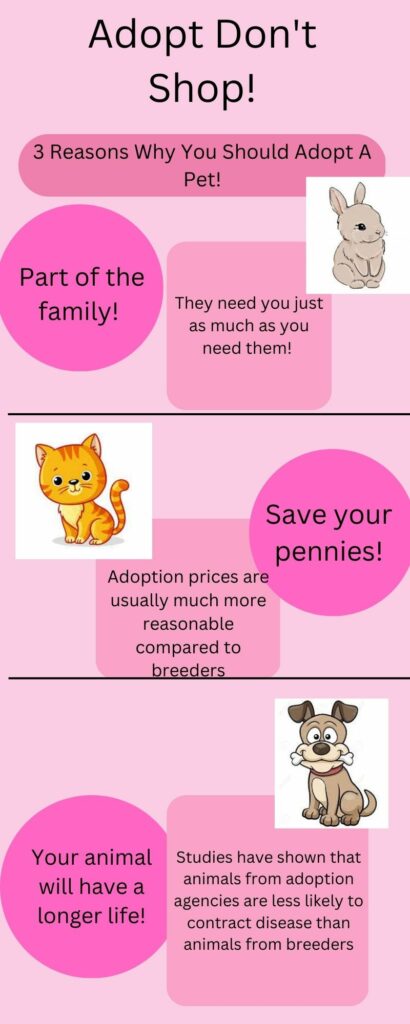Hello Again!,
As an animal lover, I am passionate about promoting responsible pet ownership and the ethical treatment of animals. That’s why last week, I created an infographic that highlights the benefits of adopting pets from shelters and rescue organizations rather than buying them from breeders.

The infographic aims to provide compelling reasons why adopting animals is a better option, both for the animals themselves and for their prospective owners. When I was first designing the infographic and had decided what I had wanted to write about, I also wanted to focus on which principles of design I was using while creating it. When looking at the colour scheme I wanted to use pinks. I created contrast by having different shades and shapes making it clear where the information was separated. I also was able to achieve this by using negative space. I acknowledge that there are definitely ways to improve my infographic. I found it difficult to write specifically what I wanted to say without overloading the information, but to cut it back it seems so vague.
There are five main Merrill’s principles of design; problem-centered learning, activation of prior experience, demonstration of skills, application of skills, and integration of skills into real-world settings. These principles emphasize the importance of creating learning experiences that are centered around real-world problems, that activate students’ prior knowledge and experience, and that provide opportunities for students to apply and integrate new skills in meaningful ways.
Throughout high school a problem I had was the lack of real world learning. I felt as if I was leaving highschool with no proper knowledge of nutrition, doing my taxes or proper budgeting. A problem that could be used to design a lesson using Merrill’s principles is a class of highschool kids that need to budget for a road trip across Canada. The lesson is designed around a real world task and is relevant to learners goals and provides opportunity for practice and application. This makes it a task centered principle. To include the activation principle, creating activities for the students to think, reflect and draw from their own experiences is important. The demonstration principle could be shown by the teacher having an example budget prepared for a similar road trip that demonstrates how to plan for the trip and factor in gas, food, and accommodation. The application principle could be applied by having the students start by doing a practice budget simulation and see how their decisions panned out. They could then use this information to further analyze their trip across Canada. That also reflects the integration principle by having the students reflect and learn from their experiences.
Backward design is an instructional design approach that focuses on starting with the end goal in mind and working backwards to design curriculum, instruction, and assessments. This approach emphasizes the importance of clear learning outcomes, and aligns all instructional activities with those outcomes. By using backward design, teachers can create more effective and engaging learning experiences for their students. The process of backward design involves three main stages. The first stage is to identify the desired learning outcomes or objectives. These objectives should be specific, measurable, and aligned with relevant standards and expectations. The second stage is to create assessments that align with the learning objectives. These assessments should be varied and aligned with the objectives, and may include both formative and summative assessments. The third stage is to develop instructional strategies that align with the objectives and assessments, and help students acquire the knowledge and skills necessary to meet the objectives and perform well on the assessments.
My lesson planning template:
Big Idea: Be able to create personal budget using an excel spreadsheet
Learning Outcome: Successfully create a budget using no external resources. Establish a strong knowledge of how the budget works and what sections of optional expenses can be adjusted to make room for inflation in further years.
Evidence of learning: Being able to look at an excel spreadsheet with incorrect inputs and be able to recognize the problem and fix it.
Assessment: Create a personal budget based on income and expenses with just the access to excel and their own personal information.
Learning Activities: Work with others on creating a budget given specific income and expenses and create a multimedia presentation on how the group did, problems they came across, and how they solved them.
Hi it seems really good and have great point of view. It demonstrates critical thinking by applying the principles of design and backward design to a real world scenario. The connection to personal learning is also evident as writer reflects on own experience in high school and the importance of real world learning. Also, the writer experiments with media exploration by designing an infographic and providing an example of a lesson plan using backward design.
Hello Lily!
Your infographic looks fabulous! You did a great job explaining what you have put into the infographic and the five main Merrill’s principles of design was very well applied into the context. Great explanation of the weekly contents especially the different stages of backward design and thanks for sharing your lesson planning template. Really enjoyed reading this blog post & keep up the good work!